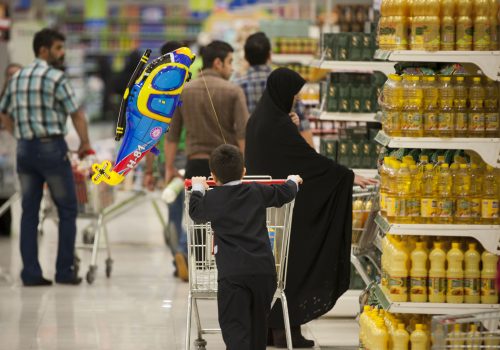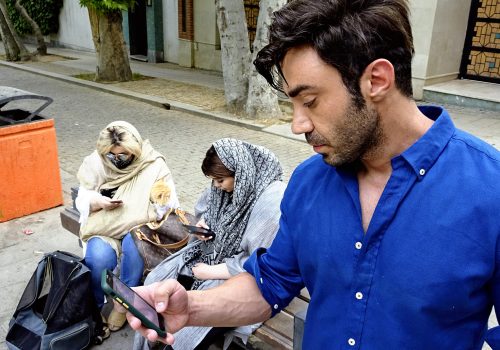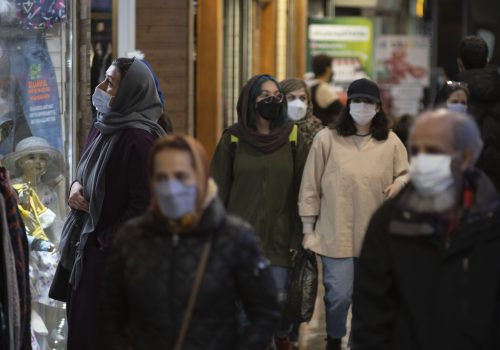Iran’s Supreme Leader threatened protesters. But Iranians aren’t listening.
On June 28, Iran’s Supreme Leader Ayatollah Ali Khamenei explicitly threatened a harsh crackdown on dissidents and proposed limits on the Internet and cyberspace, harkening back to the country’s bloody suppression of dissent during the 1980-1988 Iran-Iraq war.
His comments, which followed two similar speeches in June, came in reaction to a rising pace of protests over deteriorating living conditions in Iran.
The latest iteration of the protest movement began five years ago, as Iranians faced growing economic difficulties and hopes for reform atrophied. That wave of demonstrations subsided during the height of the COVID-19 pandemic. However, according to Human Rights Activists News Agency (HRANA), a Europe-based entity that receives information from a network of activists across Iran, there were thirty-five protests and strikes across Iran from June 11 to June 18 alone. From June 25 to July 1, HRANA said that there were another two dozen demonstrations across the country.
Khamenei, who has been in power for thirty-three years, has blamed foreign “conspiracies” for the unrest. In a June 4 speech that marked the death of his predecessor, Ayatollah Ruhollah Khomeini, he tried to downplay the protests while indicating concern about the regime’s future in an unprecedented manner. Although he said that the Islamic Republic would never be toppled, the Supreme Leader made direct references to cases in which “the deposed ruling family returned to power after a few years.” He explicitly pointed to monarchists and the possibility of their return to power, even as he branded them as reactionaries.
The leader’s threats and the brutal actions of the security forces have failed to deter unrest. On June 6, the teachers’ union called for a strike and protests in front of education departments on June 16. Security forces arrested dozens of teachers and activists in numerous provinces, including sixty in Fars, thirty-one in Kordistan, ten in Qazvin, and six in Gilan. In the capital, Tehran, more than fifty people were arrested, according to HRANA.Yet, tens of thousands of teachers turned out on June 16 in forty-six cities, including all thirty-one provincial capitals, to protest low wages, poor welfare benefits, and the release of their colleagues. The Haft-Tappeh Sugar Cane Workers Union—the largest in Khuzestan province—which regularly protests over unsafe conditions and unpaid wages, issued a statement supporting the teachers’ demands and calling for the immediate release of workers and union activists in addition to the arrested teachers.
Student protests have been on the rise, too, despite unprecedented levels of suppression. Colleges had been closed since March 2020 due to the pandemic and reopened in May. Since then, tens of students have been summoned for interrogation and a large number were expelled in only two weeks after the reopening.
The unrest has clearly shaken Khamenei. In another speech on June 12, he asked Iranians to “show restraint, be patient, and be hopeful about the future,” even as he offered no new policies. He blamed the protests on “the enemy’s soft war on the Iranian people” and the “enemy objectives of provoking the nation.”
Khamenei’s third speech in which he mentioned the protests, on 28 June, was angrier in tone. Addressing an audience that included the chief of the judiciary and other top officials, he openly threatened Iranians with the same brutality that the regime showed in the early days following the revolution and during the Iran-Iraq war. In those years, thousands of dissidents were summarily executed and tens of thousands were imprisoned. The wave of the executions peaked in the summer of 1988 when then-leader Ayatollah Ruhollah Khomeini issued a fatwa that ordered the deaths of an estimated 4,500 to five thousand political prisoners in a matter of months, known as the 1988 massacre.
Khamenei threatened the nation with a large-scale brutal and violent crackdown “similar to 1981”—when mass executions began—and asked the judiciary to also “confront the cyberspace. These [websites] worry people, they corrupt people’s minds…The current laws can be used for the purpose. If there are no laws, ratify one,” he said in reference to the so-called Internet protection bill, a draconian legislation that has been pending for months in parliament. Khamenei warned that a free Internet was undermining the “psychological security of society,” using reasoning similar to when he ordered the closure of tens of reformist newspapers in the late 1990s.
Yet, despite the clear threat, there were several protests by workers demanding better pay on June 28. The next day, pensioners in Ahvaz and other cities took to the streets, demanding an increase in their pensions relative to skyrocketing inflation and better medical insurance coverage. Meanwhile, tens of people who lost their savings to Cryptoland, a private cryptocurrency investment firm whose assets were frozen two years ago, gathered in front of the office of Tehran’s prosecutor general demanding their money be returned.
Iranians take to the streets not only for economic and welfare demands, but also for social and cultural reasons. On June 29, fans of the Esteghlal soccer team protested against the club’s management for not renewing the contract of team captain Voria Ghafouri, who has been outspoken lately in support of popular demands.
Climate-related disasters, such as floods and drought, have also triggered unrest. In this hot Iranian summer, however, even small grievances seem sufficient to persuade people to take to the streets. In mid-June, for example, a few small businesses and shops in one part of Tehran closed to protest a new tax law. The following day, the protest morphed into a general strike by other businesses in several cities in Fars and Markazi and Khuzestan provinces and to other parts of downtown Tehran.
At times, the protests achieved concrete results, like when the demands of small businesses were accepted in regard to not taxing their point-of-sale transactions. The regime was also forced to give in to the demands of teachers, workers, and pensioners, implementing an assessment system that would increase salaries by 60 percent in pace with inflation. This sort of concession has rarely happened in the history of the Islamic Republic.
The most significant feature of the protests is their non-violent nature and unyielding resolve for gradual but fundamental change. As the history of Iran in the past one hundred years has seen repeatedly, city streets can be the venue for powerful movements that can change the nature of the government. At present, the regime still has the upper hand, but there have been occasions, such as recently in Tabriz, when protestors succeeded in peacefully pushing back security forces.
The demise of the Islamic Republic has been falsely predicted many times in the past four decades. The turning point would be if security forces repeatedly fail to suppress the protests and possibly even join them.
The author, who is well-versed in the Iranian political scene, was granted anonymity to share candid observations.
Further reading
Thu, May 12, 2022
The Ebrahim Raisi government just jacked up food prices. Iranians are understandably angry.
IranSource By
The government of hardline President Ebrahim Raisi—who has been in office for less than a year—has opted to introduce coupons for almost everything from bread to Internet.
Tue, May 24, 2022
The Biden administration needs to do more on Iran. Here’s why.
IranSource By Holly Dagres
Having a consistent, actionable approach to Iran is what the Biden administration needs to stay on course with its human rights agenda. Now is a good place to start.
Thu, Jun 30, 2022
Iran’s middle class has been eroding for some time. Now it’s only getting worse.
IranSource By
With the weakening of Iran's middle class, the safety valve of the political system is eroding.
Image: Iran's Supreme Leader Ayatollah Ali Khamenei gestures during the 33rd anniversary of the death of the leader of Iran's 1979 Islamic revolution, Ayatollah Ruhollah Khomeini, at Khomeini's shrine in southern Tehran, Iran June 4, 2022. Office of the Iranian Supreme Leader/WANA (West Asia News Agency)/Handout via REUTERS


